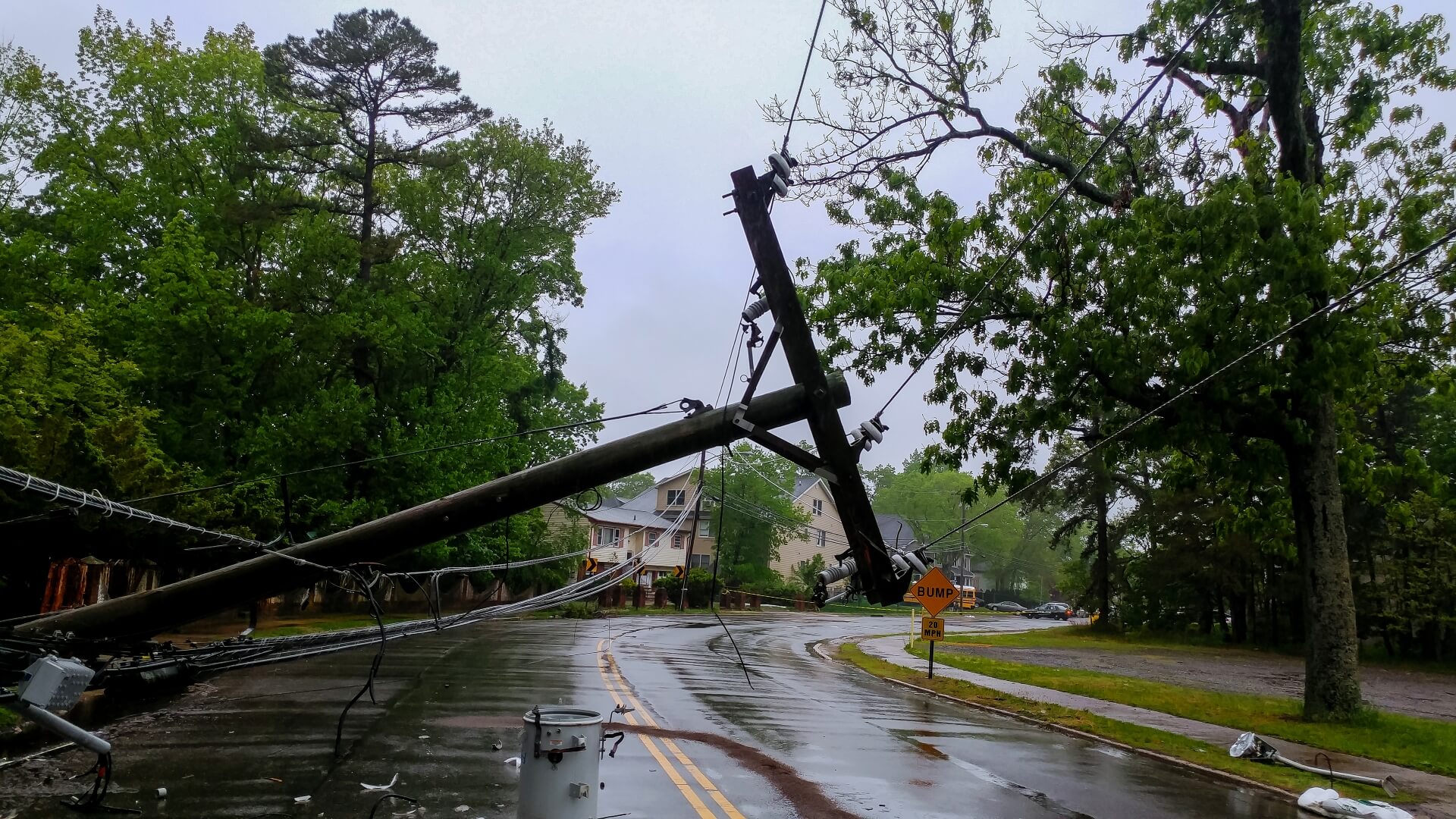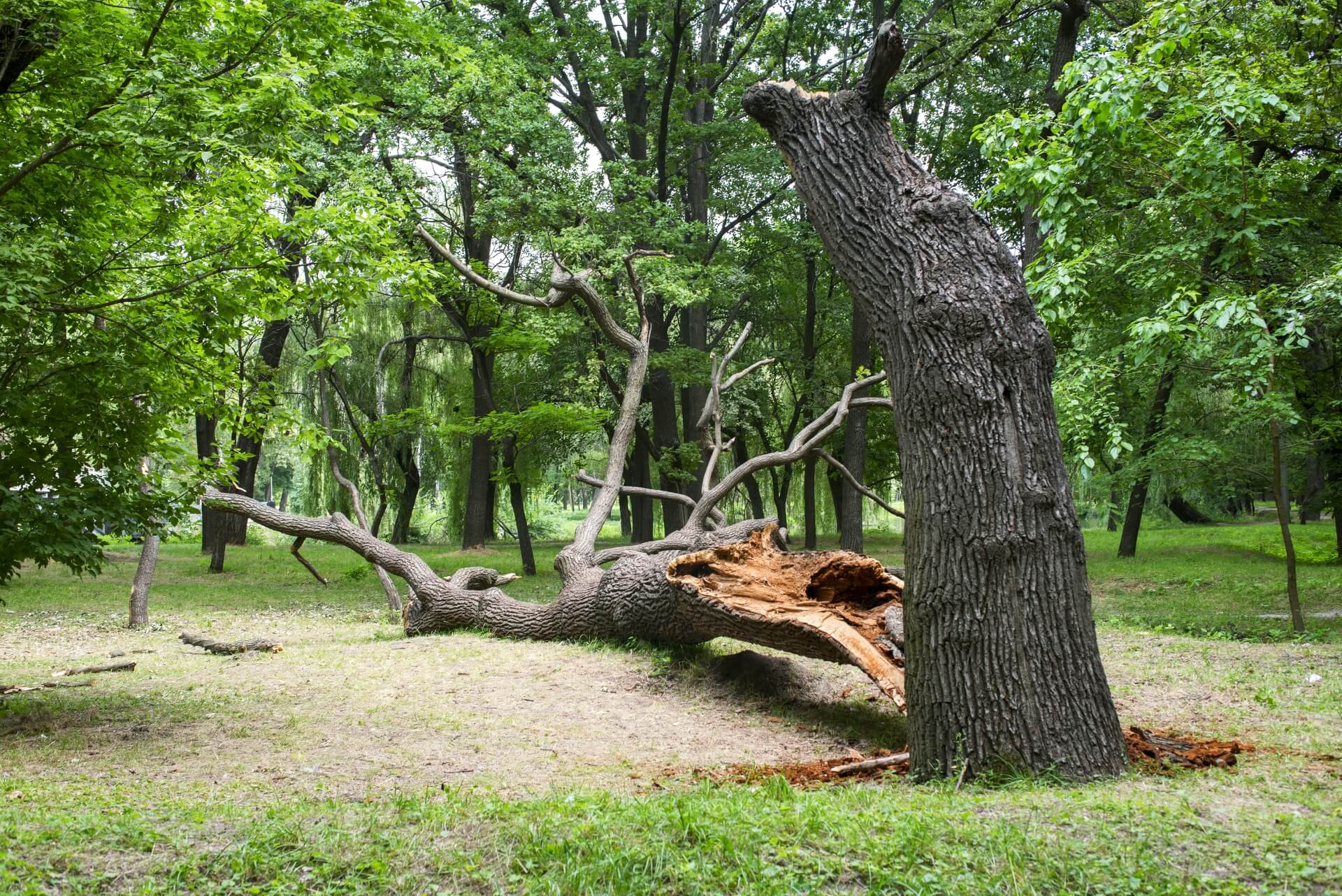When storms roll through Louisiana’s Northshore, they leave behind more than just puddles and fallen branches. Trees that looked perfectly healthy yesterday might now pose serious risks to your family and property. Learning how to assess tree health after a storm becomes a critical skill that every homeowner needs to understand, especially here in the Gulf Coast where severe weather strikes regularly.
At ArborWorks, we’ve seen it all – from minor branch damage that trees bounce back from quickly to major structural problems that require immediate attention. The good news? You don’t need a forestry degree to spot the warning signs that matter most. However, knowing when to step back and call professionals can save you thousands of dollars and, more importantly, keep your family safe.
Understanding Storm Damage: What Really Happens to Trees
Storms don’t just knock branches around randomly. Instead, they create predictable patterns of damage that trained eyes can read like a book. Wind damage typically starts with the crown, where leaves and smaller branches catch the most force. Meanwhile, saturated soil from heavy rains loosens root systems, making even healthy trees more likely to topple.
Assessing tree health after a storm starts with understanding these damage patterns. Straight-line winds often snap branches cleanly, while rotating winds from tornadoes twist and tear wood fibers. Hurricane conditions combine both problems, adding salt spray that can damage foliage miles inland.
Root systems face their own challenges during storms. Flooding suffocates roots by cutting off oxygen, while rapid soil movement can sever major structural roots. Trees might look fine above ground but be completely unstable below the surface.
Safety First: How to Assess Tree Health After a Storm Without Getting Hurt
Before you examine any tree damage, safety must come first. Stay at least 25 feet away from any downed power lines, and never assume a line is dead. Contact your utility company immediately if you spot power line issues.
Start your assessment from a safe distance. Use binoculars to check upper branches instead of walking directly under damaged trees. Look for hanging branches – arborists call these “widow makers” or “fool killers” because they can fall without warning.
Learning how to assess tree health after a storm requires patience, not speed. Take photos from multiple angles before getting closer. This documentation helps with insurance claims and gives professionals a clear picture if you need to call for help.
The 25-foot rule applies to any tree showing signs of instability. If you see soil mounding on one side of a tree or roots pulling up from the ground, that tree could fall at any moment. These situations require immediate professional attention from companies like ArborWorks that specialize in emergency tree removal.
Key Warning Signs: What to Look for During Your Assessment
Assessing tree health after a storm means knowing which warning signs demand immediate action versus those that can wait for professional evaluation.
Let’s break down the most critical indicators:
Immediate Danger Signs:
- Cracks in the main trunk that you can see daylight through
- Trees leaning more than 15 degrees from their original position
- Soil mounding or root exposure on the opposite side of a lean
- Large branches hanging in the crown, held only by bark strips
- Any tree contact with power lines or structures
Moderate Concern Indicators:
- Crown loss between 25-50% of the total canopy
- Bark damage covering more than 25% of the trunk circumference
- Multiple small cracks in branch unions or the main trunk
- Mushrooms or fungal growth appearing after the storm
- Standing water around the root zone for more than 48 hours
Long-term Monitoring Situations:
- Crown loss under 25% with no major branch failures
- Minor bark scrapes or wounds from flying debris
- Temporary wilting that improves within a few days
- Small branch damage under 2 inches in diameter
Understanding these categories helps you prioritize which trees need immediate professional tree health inspection services and which ones you can monitor over time.
The Root Zone: Hidden Damage Below Ground
Most homeowners focus on what they can see above ground, but assessing tree health after a storm requires checking the root zone carefully. Root damage often determines whether a tree will survive long-term, even if the crown looks relatively intact.
Walk around each tree and look for changes in the soil surface. Fresh cracks radiating outward from the trunk indicate root movement. Soil that appears “fluffy” or raised suggests roots have shifted or broken underground.
Pay special attention to the root flare – the area where the trunk widens as it meets the ground. This area should remain stable and unchanged. If you notice the root flare has shifted, lifted, or shows new exposure, the tree’s stability is compromised.
Standing water creates its own problems. Trees can survive brief flooding, but prolonged saturation kills root systems.
Crown Assessment: Reading the Canopy for Clues
The tree crown tells a story about storm damage and recovery potential. Assessing tree health after a storm involves calculating crown loss percentage – a key factor in determining whether a tree can recover or needs removal.
Count the major branches that remain intact versus those that broke or show significant damage. Trees losing more than 50% of their crown have poor survival prospects and often qualify for insurance coverage or FEMA assistance.
Look for hanging branches caught in the canopy. These “hangers” create ongoing safety hazards and stress points that can lead to additional failures. Professional tree trimming services can safely remove these hazards while preserving the tree’s health.
Branch attachment points reveal structural integrity. V-shaped unions with bark growing between the branches (called included bark) create weak points that often fail during storms. U-shaped unions with strong wood connections typically survive better.
Trunk Inspection: Spotting Structural Problems
Trunk damage ranges from superficial bark scrapes to deep cracks that threaten the entire tree. Learning how to assess tree health after a storm requires distinguishing between cosmetic damage and structural problems.
Surface bark damage, while unsightly, rarely threatens tree survival if it affects less than 25% of the circumference. Trees can heal these wounds naturally over time. However, damage that girdles the trunk (goes all the way around) cuts off the tree’s ability to transport nutrients and water.
Cracks deserve special attention. Shallow surface cracks might heal, but deep splits that extend into the heartwood indicate serious structural damage. Use a flashlight to check crack depth – if you can see more than an inch into the wood, professional evaluation is needed.
Cavities or hollow areas become more apparent after storms, especially if bark gets stripped away. While trees can survive with some hollow sections, large cavities reduce structural strength significantly.
Species-Specific Considerations for Louisiana Trees
Different tree species respond to storm damage in predictable ways. Assessing tree health after a storm becomes more accurate when you understand how common Louisiana trees typically react to severe weather.
Live oaks, Louisiana’s iconic trees, show remarkable storm resistance due to their low, spreading crowns and extensive root systems. They can lose substantial numbers of branches and still recover fully. However, their weight makes them dangerous when they do fail.
Pine trees present different challenges. Their tall, narrow crowns catch wind easily, and their shallow root systems make them prone to uprooting in saturated soils. Pine trees with significant crown damage rarely recover well and often require removal.
Cypress trees, adapted to wetland conditions, handle flooding better than most species but can suffer crown damage in high winds. They’re excellent at sprouting new growth from damaged branches.
Pecan trees, common in residential areas, have brittle wood that breaks easily in storms. They often lose major branches but can recover if the main trunk remains intact.
When to Call ArborWorks: Professional vs. DIY Assessment
Learning how to assess tree health after a storm includes knowing your limits as a homeowner. While you can safely evaluate ground-level conditions from a distance, certain situations require professional expertise.
Call ArborWorks immediately for:
- Any tree contact with power lines
- Trees leaning toward structures
- Major trunk cracks or splits
- Root plate lifting or soil mounding
- Large hanging branches over walkways or structures
- Crown loss exceeding 50%
- Multiple trees down across your property
Professional arborists bring specialized equipment and training that homeowners can’t match. We use tools like resistographs to detect internal decay, sonic tomography to image structural defects, and proper safety equipment for aerial work.
Our ISA-certified arborists understand liability issues and insurance requirements. We provide detailed assessments that insurance companies and FEMA accept for damage claims. This documentation often proves crucial for recovery funding.
Storm Damage vs. Pre-existing Problems
Assessing tree health after a storm requires distinguishing between fresh storm damage and pre-existing conditions. Insurance companies typically cover sudden storm damage but exclude problems that developed over time.
Fresh storm damage shows clean breaks, bright wood exposure, and damage patterns consistent with wind direction. Pre-existing problems include old decay, gradual lean development, and pest damage that weakened the tree before the storm.
Take photos that show the difference. Fresh breaks expose light-colored wood, while old damage appears dark and weathered. This documentation helps support insurance claims and guides treatment decisions.
At ArborWorks, we help property owners document storm damage properly. Our reports distinguish between acute storm impacts and chronic conditions, supporting successful insurance claims while ensuring safety priorities remain paramount.
Recovery Timelines and Expectations
Understanding recovery timelines helps you make informed decisions about damaged trees. Learning how to assess tree health after a storm includes realistic expectations about healing and regrowth processes.
Trees with minor damage (under 25% crown loss) typically show new growth within one growing season. Moderate damage (25-50% crown loss) requires 2-3 years for full recovery in healthy trees. Severe damage (over 50% crown loss) rarely leads to successful recovery.
Age and species affect recovery speed. Young, fast-growing trees bounce back quickly, while mature specimens take longer but often survive damage that would kill younger trees. The key is matching expectations to each tree’s specific situation.
Some damage doesn’t become apparent until months after a storm. Root damage might not show symptoms until the following growing season when the tree leafs out poorly or shows premature fall color.
Prevention: Preparing Trees for Future Storms
Assessing tree health after a storm is important, but preventing damage through proper storm prep & risk mitigation is even better. Regular maintenance reduces storm damage significantly.
Annual professional inspections identify potential problems before storms strike. Dead branches, weak unions, and pest problems all increase storm damage risk. Addressing these issues proactively protects your investment and improves safety.
Proper pruning reduces wind resistance without compromising tree health. The goal isn’t to thin the crown excessively but to remove problematic branches and improve structural strength. Professional arborists understand species-specific pruning needs.
Insurance and Documentation Considerations
Proper documentation during your assessment affects insurance claim success. Assessing tree health after a storm should include comprehensive photo documentation from multiple angles.
Photograph damage before any cleanup begins. Include close-ups of specific damage and wide shots showing overall tree condition. Date-stamp photos and take notes about storm timing and conditions.
Keep receipts for any emergency work performed. Insurance companies typically cover tree removal when trees damage insured structures but may not cover preventive removal of undamaged trees.
ArborWorks provides detailed written assessments that insurance companies accept. Our reports include damage quantification, safety recommendations, and cost estimates that support claim processing.
Common Mistakes to Avoid
Learning how to assess tree health after a storm involves avoiding common mistakes that can prove costly or dangerous. Never attempt to remove large branches yourself – the forces involved in storm-damaged wood are unpredictable and dangerous.
Don’t make hasty removal decisions. Many trees that look severely damaged can recover with proper care. Professional assessment helps distinguish between trees that need removal and those worth saving.
Avoid “storm chasers” who appear immediately after severe weather. These contractors often lack proper licensing, insurance, and expertise. Stick with established local companies like ArborWorks that have deep community roots and proven track records.
Working with ArborWorks: Your Post-Storm Recovery Partner
At ArborWorks, we understand that assessing tree health after a storm can feel overwhelming when you’re dealing with property damage and family concerns. That’s why we offer comprehensive post-storm services designed to make recovery as smooth as possible.
Our ISA-certified arborists respond quickly to emergency situations while providing thorough assessments for non-critical damage. We work directly with insurance companies and understand FEMA requirements for storm damage documentation.
Call us at (985) 951-0128 for immediate storm damage assessment. Our team serves the greater New Orleans area with 24/7 emergency response capabilities.
Frequently Asked Questions
Q: How quickly should I assess my trees after a storm? A: Begin your visual assessment as soon as it’s safe to go outside, but avoid getting close to damaged trees for at least 24 hours. Many additional branches fall during this period as stress redistributes through the tree.
Q: Can a tree survive losing half its branches? A: Trees can survive significant branch loss, but recovery depends on species, age, and overall health. Generally, healthy trees losing less than 50% of their crown have good recovery prospects, while those losing more than 50% face poor survival odds.
Q: Does homeowner’s insurance cover storm-damaged trees? A: Most policies cover tree removal when trees damage insured structures like houses, garages, or fences. They typically don’t cover trees that fall in yards without hitting structures or preventive removal of damaged but standing trees.
Q: How long should I wait to see if a damaged tree recovers? A: Give trees one full growing season to show recovery signs. Trees leafing out poorly or showing continued dieback after a full year likely won’t recover. However, safety hazards require immediate attention regardless of recovery potential.
Q: What’s the difference between storm damage and normal tree maintenance? A: Storm damage happens suddenly during severe weather events, while maintenance addresses gradual problems that develop over time. Insurance typically covers sudden storm damage but excludes maintenance issues.
Conclusion
Learning how to assess tree health after a storm combines safety awareness, basic observation skills, and knowing when to call professionals. While homeowners can safely evaluate many aspects of storm damage, complex structural problems require expert assessment.
The key is starting with safety, documenting everything, and making informed decisions about which trees to save versus remove. With proper assessment and professional guidance, many storm-damaged trees can recover fully and continue providing value to your property.
Remember that storm damage assessment isn’t a one-time event. Trees may show delayed symptoms weeks or months after a storm, making ongoing monitoring important for long-term safety and tree health.
Ready to get your trees professionally assessed after storm damage? ArborWorks provides comprehensive post-storm tree evaluation services throughout the New Orleans area. Our ISA-certified arborists offer emergency response, detailed assessments, and complete recovery services. Contact us today at (985) 951-0128 to schedule your post-storm tree assessment and protect your property investment.




